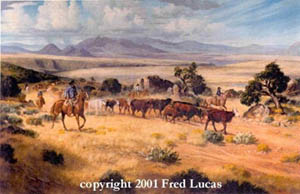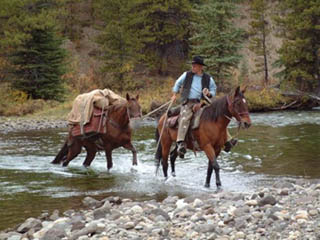|
An Overview
Picture taken from http://www.fredlucas.com Chock full of danger, death, heroism, cowardice, and an overwhelming sense of Mexican pride, it is no wonder the Corrido de Kiansis has endured though the ages. Composed during a period of cattle drives from Texas to Kansas (pronounced “Kiansis” by the Texas Mexicans) in the 1860s, the Corrido de Kiansis has evolved two distinct variations which Américo Paredes named Kiansis I and Kiansis II for simplicity’s sake. Kiansis I, popular among men born in the 1860s, is usually sung by a single performer in a “slow, reflective tempo” (Texas-Mexican 53). Often referred to as the “old tune,” this version tells the story of a group of Mexican vaqueros led by a valiant caporal that braves fearsome steer and a formidable river to deliver a herd of cattle to Kansas (Texas-Mexican 25). In contrast, Kiansis II is usually sung by two performers, often with the accompaniment of a guitar and several gritos from the audience (Texas-Mexican 53). It also differs from Kiansis I in that it refers to two women: the caporal’s wife and the mother of a vaquero killed by a bull. In both versions, however, the Mexicans prove their superiority over the Americans when it comes to cattle herding. This common trait is no coincidence. The vaqueros’ finely tuned skills and the corridistas’ boasting highlight the intercultural conflict between Mexicans and Anglos. As in Gregorio Cortez, these vaqueros “embody in a singular manner the resistance of a proud but subjugated people” (Peña 14). Subjugated? Yes, subjugated. Ever since Texas declared its independence from Mexico in 1836, the Mexicans living in Texas found themselves unwelcome in a land which was once their own. After the Treaty of Guadalupe Hidalgo in 1848, they officially became United States citizens—unofficially, second-class citizens. Mexicans “were cheated out of their property by English-speaking newcomers and suffered all kinds of indignities from the new masters of the land” (Texas-Mexican 22). The hatred sparked by this mistreatment resulted in the first two corrido-like folksongs known to analysts.
Picture taken from http://www.tpheart.com/TeepeeHeart110CD.html The first song in which analysts see many corridolike traits is one about a man, Juan Nepomuceno Cortina, who shoots a city marshal for beating up one of his mother’s workers and starts his own rebellion against the white authority (Texas-Mexican 23). Unfortunately, only parts of this song have been recovered, so El Corrido de Kiansis remains the oldest complete corrido. |

